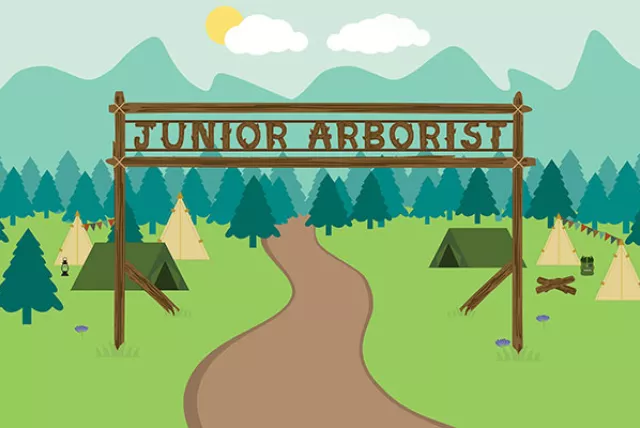
If you’re an educator looking to bring trees into the classroom, you’re in the right place.
Here, you’ll find everything from tree facts to videos to hands-on activities. Your school can even use these resources to help earn recognition for inspiring young tree planters through our Tree Campus K-12 program.
Seven Life Stages of a Tree
Stage One: Infant
The first life stage a tree goes through is infancy, just like us humans.
During this phase, trees are at their most vulnerable. Trees are very thin and small, though some may quickly grow taller than the average human.
Infant trees will often survive just fine on their own, but with coaxing, care, and a little attention, infant trees can grow tall and strong.
Stage Two: Youth
The second stage a tree goes through in its life is youth. Trees in this “teenage” phase, have long, slender branches, and pointed tops.
To care for youth and infant trees, they need protection and room to grow while they establish themselves in their surroundings.
At this stage, their growth and form can be influenced, but their small size makes them easy to damage or kill with thoughtless action. When they are kept uninjured and free to grow, they respond with fast growth, solid establishment, and good health.
Stage Three: Prime of Life
Stage three is next: the tree’s prime of life. Trees in their prime have full, round-topped crowns, filled with long, strong branches.
Now is the time to sit back and enjoy your tree. Trees in their prime of life will take care of themselves with little outside help.
Shade trees will offer almost no trouble except an occasional interfering or dead lower branch that may need removing. In forest situations, selective thinning will often encourage even greater growth and better health. Resist the urge, however, to make a premature harvest. Let your tree continue to grow.
Stage Four: Middle-Age
The fourth phase in a tree’s life is middle-age. Their crowns will flatten out as limbs grow thicker and heavier.
Shade trees at this stage are usually spectacular. They are still in good health and will begin to develop their own unique character.
Watch for insect and disease attacks that may reduce tree health. Meanwhile, enjoy its benefits as the tree continues to age.
Stage Five: Senior
Trees become seniors at stage five. Senior trees have flat-topped canopies of heavy limbs, sometimes covered in short sprouts. Gaps start appearing in the canopy as the major limb systems start dying out.
To keep your tree in good health at this stage, and during middle-age, it is a good idea to keep dead limbs pruned out of the tree. Watch for insect and disease attacks that may reduce tree health. In the forest, watch for tree health and growth rates so harvesting returns can be optimized.
While the tree has many more years to live, it is nearing the end of the life stages.
Stage Six: Twilight
At the end of their life, trees reach their twilight, stage six. Large limbs die and break off, leaving a small crown of scattered large limbs and short twigs.
Monitor the tree’s base, and make sure it is not becoming unsound. Shade trees can be kept safe by continuing to remove dead limbs. When caring for trees in their twilight, it helps to remember that, for many trees, this phase can last for as many as fifty years; they usually don't go in a hurry.
Stage Seven: Death
All trees will inevitably die at some point, and rest in peace. A dead tree can provide a good habitat for wildlife, providing food and shelter.
Trees that have died in hazardous areas should be removed immediately. Otherwise it can be left alone to fall apart in place. When the tree finally falls, it will decay back into the soil.
What tree rings can tell us
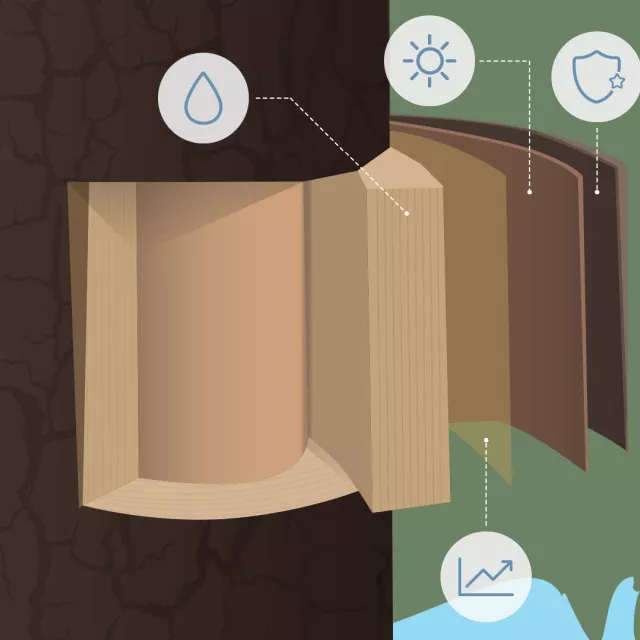
This 62-year old loblolly pine has quite the story hidden in its inner layers. Let’s take a look at what makes up a tree trunk.
-
The outer bark is the tree’s protection from the outside world.
-
The inner bark, or phloem, is the pipeline through which food moves from the leaves to the rest of the tree.
-
The cambium cell layer is the growing part of the trunk, producing new bark and new wood each year.
-
The sapwood, or xylem, is where water moves from the roots up to the leaves.
-
Heartwood, made of old xylem, is the central, supporting pillar of the tree.
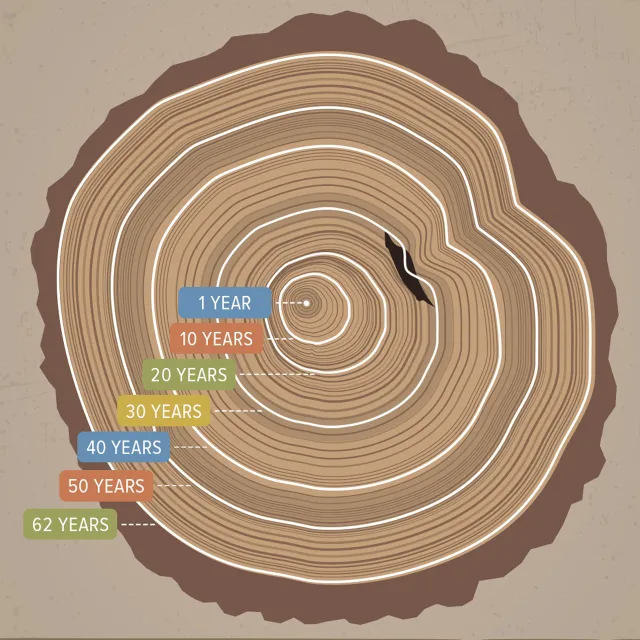
Each year, for 62 years, this tree has added a new ring of xylem cells to the trunk. If a slice of the tree could be viewed, it would look like this. Each ring in this tree cross section represents another year of growth.
- Every spring and summer, a tree adds new layers of wood to its trunk. The wood formed in spring grows fast and is lighter because it consists of large cells.
- In summer, growth is slower, forming smaller cells that produce darker wood. So, when the tree is cut, the layers appear as alternating rings of light and dark wood.
- You can tell how old the tree is by counting the dark rings, one for each year. And these rings tell us a lot about what has happened to the tree over the years.

62 years ago, a little loblolly pine sprouted when a seed fell out of a pine cone and became rooted in the soil. For 5 years this little tree grew, adding a new ring each year. The rings for each of these five years are nice and broad and evenly spaced. This tells us that the little tree enjoyed plenty of rainfall and sunshine.
When the tree was 6 years old, something pushed against it, making it lean. You can see the rings on one side are now wider, as the tree built “reaction wood” to help support it.

10 years later, whatever was pushing against it was removed and the tree started to grow straight again. But its bigger neighbors were growing too, and their crowns and root systems took much of the water and sunshine.
After some years of competition, the surrounding trees had either fallen or been harvested. With the larger trees removed, there was once again plenty of rain and sunlight for the tree. The wider rings show the tree began growing rapidly again.

A fire swept through the forest. Fortunately, the tree was only scarred. Year by year, the fire scar was covered by newly formed wood. In recent years, the newly formed rings became thin and c se together. This may have been caused by a prolonged dry spell. One or two dry summers would not have dried the ground enough to slow the tree’s growth this much.
Fifteen years later, another series of narrow rings may have been caused by an insect like the larva of the sawfly. It eats the leaves and leafbuds of many kinds of coniferous trees.
Tree rings offer us a glimpse into the past — a unique look at the life of a tree.
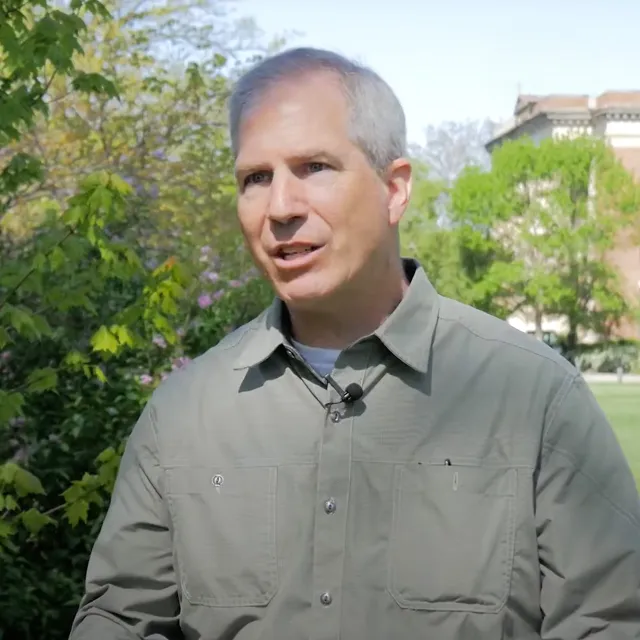
Video Library
Join Pete, our resident arborist, as he shares some identifying features of common trees! Then, see if your students can find one while they’re out and about.
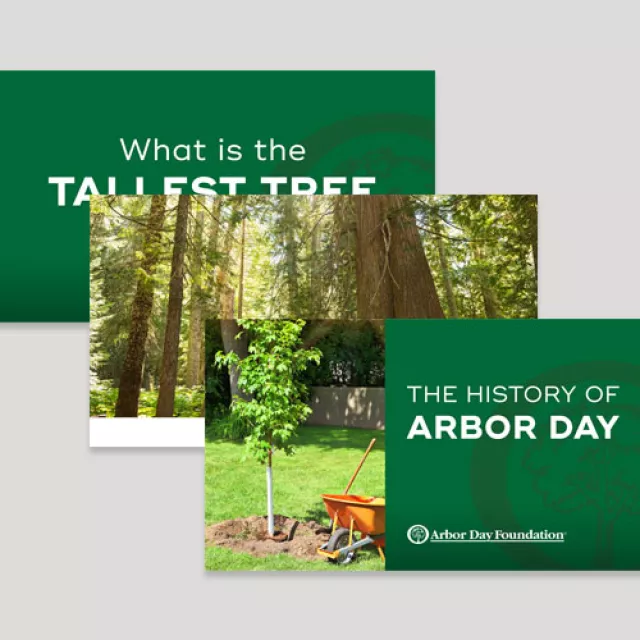
PowerPoint Presentation
Share the history of the oldest environmental holiday in the United States with your students through this PowerPoint presentation.
Your school can earn recognition from the Arbor Day Foundation for using trees as a learning tool.
Printed Activity & Coloring Sheets
Explore our collection of fun and engaging activity and coloring pages designed for kids of all ages!



